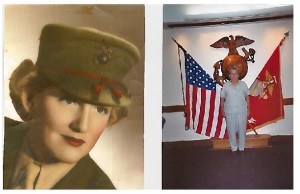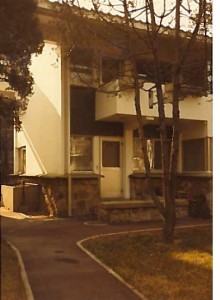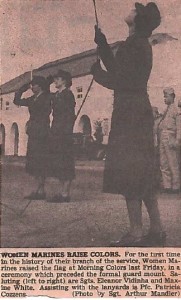Grace Maxine Wade, Woman Marine
By Ruth E. Starr
 Maxine White (aka Grace Maxine Wade) joined the U.S. Women Marines in 1951. The US Marine Corps did not allow women to fight in battle but recruited women to serve in other jobs to free up men that were trained to fight enemies on a battlefield.
Maxine White (aka Grace Maxine Wade) joined the U.S. Women Marines in 1951. The US Marine Corps did not allow women to fight in battle but recruited women to serve in other jobs to free up men that were trained to fight enemies on a battlefield.
In her own words, Grace said in an interview “I became patriotic over many years but at the beginning of my career days the military appealed to me. After WWII, women were just beginning to serve in the military. I went down to the recruiting office in 1951 to join the Coast Guard but they were not taking women at that time; so I ended up in the Marines. It was meant to be at the time, for me to be a Woman Marine. I took a lot more from the Marines than I ever gave. I was a clerk typist in a battalion office my whole tour in the Marines. It was not politically correct for women to join the military at that time. It was considered a place to go to meet men. However, I didn’t feel that way being in the Marines. There was some feeling that women shouldn’t be in the military at all.
“After six weeks of boot camp I was sent to clerk typist school at Parris Island, where all women go for training, later I was assigned to the Marine Corps Recruit Depot in San Diego.  Our boot camp instructor told us that we were 1st Ladies and then Marines. We were not to forget that we were women.I think Major William Barber, who won the Congressional Medal of Honor for his action in Korea at the Chosin Reservoir, was the executive officer of the 1st Marine Battalion at that time. Where I worked there were other Women Marines in an office that was responsible for maintaining the records files, and I heard a lot of war stories from Marines while I was working there. There were 15 people in the office and maybe three were women. We handled all the military service record books (SRBs) for the Battalion. I remember one officer, who had been a POW of the Japanese in WWII, tell many stories about his experiences. It was fascinating to me. Mostly it was a remark or two about the war. I remember one Marine said he would never live in a cold climate because it was so cold in Korea that winter. I never heard a complaint, maybe a gripe, but never heard a complaint.”
Our boot camp instructor told us that we were 1st Ladies and then Marines. We were not to forget that we were women.I think Major William Barber, who won the Congressional Medal of Honor for his action in Korea at the Chosin Reservoir, was the executive officer of the 1st Marine Battalion at that time. Where I worked there were other Women Marines in an office that was responsible for maintaining the records files, and I heard a lot of war stories from Marines while I was working there. There were 15 people in the office and maybe three were women. We handled all the military service record books (SRBs) for the Battalion. I remember one officer, who had been a POW of the Japanese in WWII, tell many stories about his experiences. It was fascinating to me. Mostly it was a remark or two about the war. I remember one Marine said he would never live in a cold climate because it was so cold in Korea that winter. I never heard a complaint, maybe a gripe, but never heard a complaint.”
“Much later after the war ended, when I returned to work in Korea at the embassy, I saw a lot of business growth in the area. The Korean people did not waste their aid from the Americans. They built the country up from ashes. Between WWII and the Korean War there was only six years and I heard that the only building that was not destroyed was the train station. The original train station was still there, over 25 years later. Then in 1988 the South Koreans hosted the Olympics. They worked very hard to get the country ready for the Olympics. When I was at the embassy in Seoul Korea I met, just by chance, a former U.S. Army nurse who had been a nurse in a MASH unit during the Korean War. She also came back to Korea for the Olympics in 1988.”
Between WWII and the Korean War there was only six years and I heard that the only building that was not destroyed was the train station. The original train station was still there, over 25 years later. Then in 1988 the South Koreans hosted the Olympics. They worked very hard to get the country ready for the Olympics. When I was at the embassy in Seoul Korea I met, just by chance, a former U.S. Army nurse who had been a nurse in a MASH unit during the Korean War. She also came back to Korea for the Olympics in 1988.”
“At one point I received a letter from the President of Korea thanking me for my service. They are so thankful and grateful to America for helping to save the country. They treated us all very well. There were troops from many countries involved in the war.” In my job at the embassy in Korea, from 1987-1990, it was the most exciting and most interesting job of my career. It was very common for us to work long hours to open new markets in Korea for U.S. businesses and Korean businesses wanted to sell their products in the U.S. We worked very hard to promote American products in Korea and we helped Korean businesses become recognized. It was an exciting time to be in Korea. The city is very modern now. They have an excellent education system.
 In the picture shown of the flag ceremony, Maxine participated in raising the flag
In the picture shown of the flag ceremony, Maxine participated in raising the flag
for the Women Marines’ Birthday. Usually the MPs raised the flag every day but for the Women Marines’ birthday Maxine was one of four women who were selected to raise the flag that day. It was the 1st time that Women Marines had ever been allowed to raise the flag. They usually had a troop parade every Friday and special occasions. It was part of the training, learning to march in formation and stay sharp.
About Women in the Marine Corps Reserves
In August 1950, for the first time in history, the Women Reserves were mobilized for the Korean War where the number of women Marines on active duty reached a total strength of 2,787. Like the women of two previous wars, they stepped into various jobs to free up male Marines for combat duty. Women continued to serve in an expanding range of duties.  During this period, the Marine Corps also began opening up career-type formal training programs to women officers and advanced technical training to enlisted women.
During this period, the Marine Corps also began opening up career-type formal training programs to women officers and advanced technical training to enlisted women.
Parris Island, S.C. is the site of the Marine Corps Recruit Depot (MCRD) — the place where every female marine recruit and male recruits who live east of the Mississippi River go through boot camp. The women and men who pass through Parris Island undergo 13 weeks of intensive training which includes basic drills, combat shooting, swim qualifications and first aid.